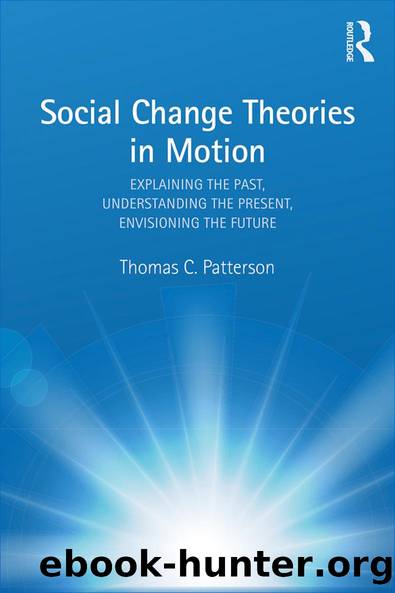Social Change Theories in Motion by Thomas C. Patterson

Author:Thomas C. Patterson [Patterson, Thomas C.]
Language: eng
Format: epub
Tags: Social Science, Anthropology, General, Sociology
ISBN: 9781351137645
Google: ACpKDwAAQBAJ
Barnesnoble:
Publisher: Routledge
Published: 2018-02-01T02:32:56+00:00
Theories of Economic Growth and Modernization
Concerns with full employment, the reconstruction of capitalist economies in Europe (1948â1952), and the extension of foreign aid to the âunderdevelopedâ countries of Asia and Africa after 1952 once again brought issues of economic growth and development to the fore. Growth and development appeared as a potent panacea. This âgrowth maniaâ had its immediate roots in Keynesâs recommendation during the Great Depression that governments should intervene in their economies to resolve the pressing issue of unemployment. His General Theory of Employment, Interest and Money (1936) focused on the insufficient demand for commodities as the main cause of unemployment; it deployed âexplicitly static assumptions of constant technology, population and capitalâ (Kurihara 1968:131, emphasis in the original). In 1939, British economist Roy Harrod (1900â1978) examined longer-term situations in which certain forces operated steadily to increase or decrease certain magnitudes in the system (Harrod 1939:14). His dynamic economics relied on the interplay of a limited number of economic variables to explain sustained growth over a period of time. The accelerator for growth in the long run was increased investment in more efficient capital and more productive technologies that would absorb a steadily growing number of workers. Two implications of his theory were that growth might potentially be continuous and, hence, that equilibrium might not be achieved. In contrast, U.S. economist Robert Solowâs (1924â) neoclassical account argued that, in the short run, growth is determined by movement toward a new steady-state equilibrium (Solow 1956).1
Development economist Paul Streeten (1917â) described the economic growth theories of the late 1940s and early 1950s in the following way:
Deeply embedded in current thought on development is the view that each country passes, at different times, through a series of comparable stages of development; that there are basic similarities in this process; and that we can therefore learn from the pre-industrial phase of now industrialised societies lessons which are applicable to underdeveloped societies today.
(Streeten 1972:5)
Download
This site does not store any files on its server. We only index and link to content provided by other sites. Please contact the content providers to delete copyright contents if any and email us, we'll remove relevant links or contents immediately.
Cecilia; Or, Memoirs of an Heiress — Volume 1 by Fanny Burney(32091)
Cecilia; Or, Memoirs of an Heiress — Volume 3 by Fanny Burney(31481)
Cecilia; Or, Memoirs of an Heiress — Volume 2 by Fanny Burney(31435)
The Great Music City by Andrea Baker(30930)
We're Going to Need More Wine by Gabrielle Union(18663)
All the Missing Girls by Megan Miranda(14854)
Pimp by Iceberg Slim(13828)
Bombshells: Glamour Girls of a Lifetime by Sullivan Steve(13718)
Fifty Shades Freed by E L James(12936)
Talking to Strangers by Malcolm Gladwell(12916)
Norse Mythology by Gaiman Neil(12879)
For the Love of Europe by Rick Steves(11664)
Crazy Rich Asians by Kevin Kwan(8912)
Mindhunter: Inside the FBI's Elite Serial Crime Unit by John E. Douglas & Mark Olshaker(8750)
The Lost Art of Listening by Michael P. Nichols(7190)
Enlightenment Now: The Case for Reason, Science, Humanism, and Progress by Steven Pinker(6891)
The Four Agreements by Don Miguel Ruiz(6343)
Bad Blood by John Carreyrou(6295)
Weapons of Math Destruction by Cathy O'Neil(5871)
